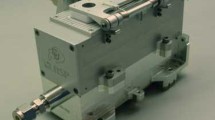Abstract
DURING the early part of this year, the nocturnal atmospheric emission in the near infra-red (to 15 microns) has been observed at College, Alaska, using a standard Perkin–Elmer single-pass monochromator with a rock-salt prism and thermocouple detector. The instrument was directed toward the southern sky, at about 20° above the horizon, giving an optical path of about four air masses.
Similar content being viewed by others
References
Harang, L., “The Aurorae” (Wiley and Sons, New York, 1951); Störmer, C., “The Polar Aurora” (Oxford, 1955).
Van Allen, J. A., “Scientific Uses of Earth Satellites” (Univ. of Michigan Press, Ann Arbor, 1956).
Author information
Authors and Affiliations
Rights and permissions
About this article
Cite this article
MURCRAY, W. A Possible Auroral Enhancement of Infra-red Radiation emitted by Atmospheric Ozone. Nature 180, 139–140 (1957). https://doi.org/10.1038/180139a0
Issue Date:
DOI: https://doi.org/10.1038/180139a0
- Springer Nature Limited
This article is cited by
-
Effets de l'activité solaire sur l'ozone atmosphérique et la hauteur de la tropopause
Geofisica Pura e Applicata (1961)





